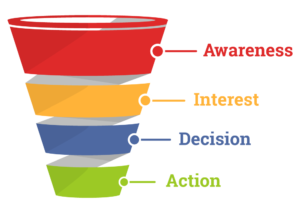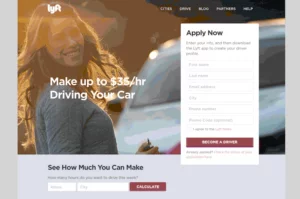If you’ve had an affiliation with business or the way it is conducted, chances are that you might have heard of the word ‘sales’, but have you heard about the “sales funnel?”
How do successful businesses manage to hold consistent sales? Have you ever found yourself asking this question? Well, you’re not alone.
The following piece of literature will provide you a beginner’s guide of the different stages that a customer goes through before buying your product.
Topics on Agenda:
Sales Funnel
Importance of Sales Funnel
Understanding the Stages of Sales Funnel
— Awareness
Content-Type
— Interest
Content-Type
— Decision
Content-Type
— Action
Conclusion
If you have ever tried to sell something, you would know how tough it can be. You might be able to generate a sale but to set atone for a continuous generation of revenue is a tough nut to crack.
So is there a magic spell out there that could get your business to operate efficiently?
We know what you’re thinking, “Magic spell”; childish right? But the truth is that there is a spell that is guaranteed to make your business boom. Engage customers better than ever and get them to advocate for your product in the long haul. It’s called the sales funnel.
But what is the sales funnel and why is it so important?
The Sales Funnel:
The sales funnel is a concept of marketing that illustrates the journey of a customer from point one to the moment a purchase is made.
But why a funnel? Why not symbolize it with a better shape? Well, the funnel is an analogy of the journey as in the beginning, your potential customers are said to be standing at the top of the funnel.
But only a fraction of these people actually come out from the bottom and make an actual purchase from you.

Example:
Let’s suppose you own an e-commerce business that sells electronic household devices. You know your target audience could range from age 25 to 65 with a blend of males and females. Where do you find people that fit those criteria the most? Facebook.
You run an awesome Facebook ad that directs your prospects to the landing page. There you tell them to sign up with their email IDs for a special offer on their way. They follow the instructions.
Read more: 4 Proven Ways to Drive Traffic to Your Website
Your prospects are now your leads. They continue going through a system, or, a funnel!
With the assets signed up to your database, you begin enlightening them about your products, about how it is better, cheaper, and more reliable. They love it.
Now you send out your products up for selling but with an even better offer of prices. They love what you’re offering and you begin selling.
Notice how you had a certain stage that you put your customer to go through, each one making your prospect more committed towards your brand goals.
That is how the sales funnel operates. The stages of the sales funnel are described in a variety of words. We’re going to use the most common ones.
The 4 basic stages of the sales funnel are:
1) Awareness
2) Interest
3) Decision
4) Action
Understanding Stages of The Sales Funnel:
Before building a sales funnel for your business, it is important that you determine the nature of your business and the vision it carries.
With a proper e-commerce marketing strategy in mind, you can add as many stages to the funnel as you want.
But in general, the sales funnel is comprised of 4 stages:

Awareness:
The first stage of the funnel could be referred to as a “ground building” stage. This is where people get to know about your business via an ad, a post, or a general mention by a friend.
This is the stage when a person finds you intriguing and visits your website for the first time and becomes a prospect.
Content-Type:
At this point, you’re looking for ways to further intrigue the person and get him to return to your website or further engage later on.
The type of content that you’re going to go with at this stage is reassuring and effective. Remember you’re only making yourself known at this stage, the sales will come.
Landing pages on your website is the best way to serve this purpose.

Read more: 7 Ways to Increase Engagement on Instagram
Interest:
At this stage, the prospect is looking for solutions. He’s comparing his past options with the future, researching for better outcomes.
This is where you come into play with your seducing content only to fill up the name of your brand in the void created in your prospect’s mind.
You get your prospect to form a connection by signing up through email. Your prospect is now a lead.
At this stage, it is important that you create a need in the customer’s mind instead of selling. Why?
The gesture of selling at the beginning could turn the potential customer off. Therefore, right now, he needs to know more about business. Deliver it.
Content-Type:
You need strong, commanding content at this stage. The one that was is both engaging but subtle at the same time.
Address their issues, ask them what they lack, and tell them that you’re here to resolve the hassles of the past.
Decision:
This is the defining stage of the sales funnel and relatively, your business as well.
This is when the customer is ready to make a purchase, but he normally has three or four options that he’s going to choose from.
Now is your time to swoop in with your best offers, where the customer has cash in his hands; you just want him to direct it towards you.
Exploit their best interests; take a leap further ahead of your competition.
Content-Type:
This is where it gets tricky. You need your content to possess the right amount of complexity to alter the customer’s minds.
Sales pages and webinars are ideal to see this stage of the funnel through.

Action:
This is the bottom of the funnel. You have made the sale. Your customer is now a part of your business.
What happens next? Yes, the customer made it through the sales funnel but he’s going to need you again. Now you’re looking for retention.
Make sure you close off with a gesture of continuation. Tell them you’ll be right here when you need them again…. because they will need you again.
Conclusion:
There are always two ways of conducting business, where one is a lot more frustrating than the other.
While in a business, you should not be looking for “Hope Marketing” where you leave the buildup, leads, and sales to the heavens.
It is better to follow the second way, where you construct a proper system and relay your work according to that very system.
Now you know about the importance of the sales funnel and how you could bring it to function for effective business.




